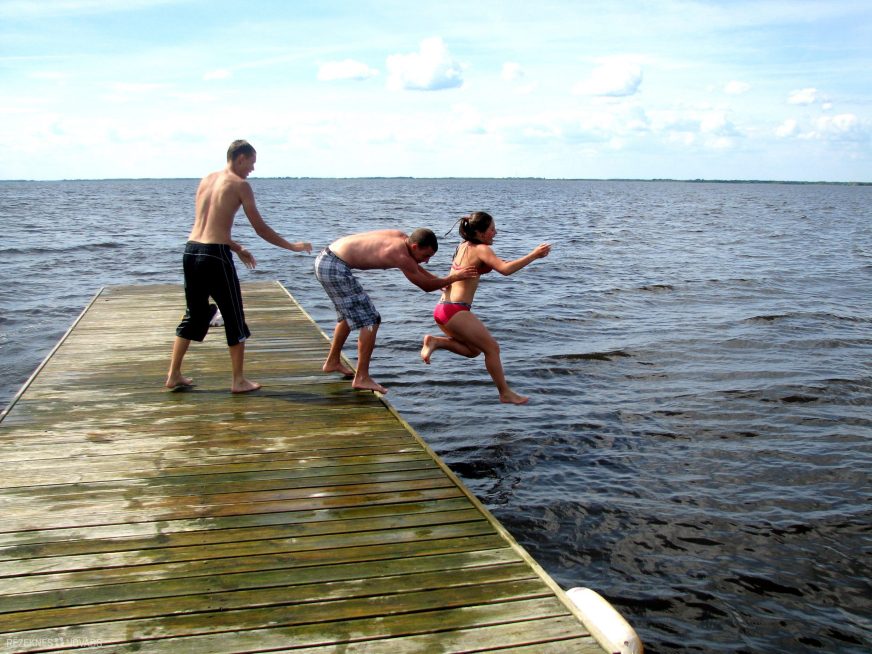What can be done in the water cordage band?

By the time of the hot time, people are increasingly reluctant to rest in nature and especially in the vicinity of lakes and rivers, but sometimes there is a disagreement between the rest of the holidaymakers – one wants to rest on the banks of the waters, while the other are defending their territory and do not want strangers to be placed in the vicinity of the water. Who's right? Responsibility of the District Development Division of Rezekne, Brigita Arbidane, is responsible:
The cordage zone in Latvia is laid down in the fisheries law, as a land zone along the coast of waters, which is intended for activities related to fishing or shipping and for pedestrians. So the cordage band can be used to walk along the coast of the waters, sunshine, swimming, fished or landed by boat or boat. Fishing shall include both recreational fisheries and underwater hunting carried out for recreational or sport purposes and self-consumption, commercial fishing and industrial fishing. The rights guaranteed by the cordage zone are described in Article 9 of the Fisheries Act.
The cableway is not to be determined unless the private waters are owned by the same owner and that the fishing rights in these waters are not owned by the State. In practice, the cordage bands are not merely lakes that are entirely on the land of one owner. As soon as the land has at least two owners or part of the land in the possession of the State or local government, the norm of the law regarding the cordage band shall come into effect.
The width of the natural cordage (that is, along the coast of natural waters) is: along the coast of private waters – 4 metres; along the coast of the other waters – 10 metres; along the sea coast – 20 metres. The bandwidth of the cordage: along the rivers of rivers and lakes, from the normal waterline; along the rivers of rivers and lakes, from the top of the coast. The bandwidth of the cordage then includes the land from the water level to the landfall and the slope itself. Along the artificially constructed channels, hydrotechnical structures and other structures of structures, the band of water cables shall be determined in the relevant building plan.
Along the coast of the sea, the cordage is demarcated by special signs, but it is not necessary along rivers and lakes. In any event, the owner of the land border plan shall have a restriction on the right of use in favour of the other members of the public. The owner of the land shall not interfere with the movement of pedestrians within these limits, as well as impose a fence or other obstacles.
Section 9 of the Fisheries Law stipulates that the free use of the cordage band without prior co-ordination with the landlord is intended for the monitoring and research of pedestrians, fish resources and waters, border guards, as well as for the performance of environmental protection, fire safety and rescue measures. After co-ordination with the landowner, the landing of boats and ships, their landing and temporary storage, the wintering, construction and repair of boats and ships; the establishment of fishermen's cloaks, recreational activities, the drying of gear and other activities related to fishing; the establishment of waterborne camps. These activities may be carried out in compliance with environmental standards, but at national border water bodies, including the requirements of the national border regime.
It is also possible to swim and ride a boat if the river or lake is not in the list of public lakes (except lakes located on the land of one private owner). Running water cannot belong to a private owner. If a private owner owns a river section, it means that he has ownership of the bearing and the right to the river itself, such as the use of its water power. It is also permitted to swim or ride a boat through a private river section, but without co-ordination with the owner, the boat shall not be dragged or camped. The structures permitted in the cordage band are mainly pedestrian kindles, boat berths, but any construction must be co-ordinated in writing with the construction board of Rezekne District. In addition, if construction is planned in the territory of the Razna Nature Park, it must also be performed with the Razna Nature Park Administration.
The people of Rēzekne convey the attention of the people to the fact that the cableway provides their right to use water for recreational and free movement along their coast. The Rēzekne Municipality is the River Rēzekne and 16 lakes (Raznas, Luban, Chernoste, Dziļuta, Feimaņu, Iberpoles, Kaunatas, Meuranium, Pušas, Rushon, Salai, Tiskada, Viraudas, Verdeshan, Zosnas, Zogota-Ismera), who are free to walk, sunshine, swimming, and the owners of the land lying on the lake are not eligible to be banned or fenced by the owners of the lake in the area of the lake. If the owner of the land violates the law and prevents the use of the cordage band, a submission to the local government may be submitted, requesting the rights specified in the law. We emphasise that the use of the cordage band is not only a right, but also a duty – to behave quietly, not to use loud music records, to collect their waste and to clean up the coastal area.